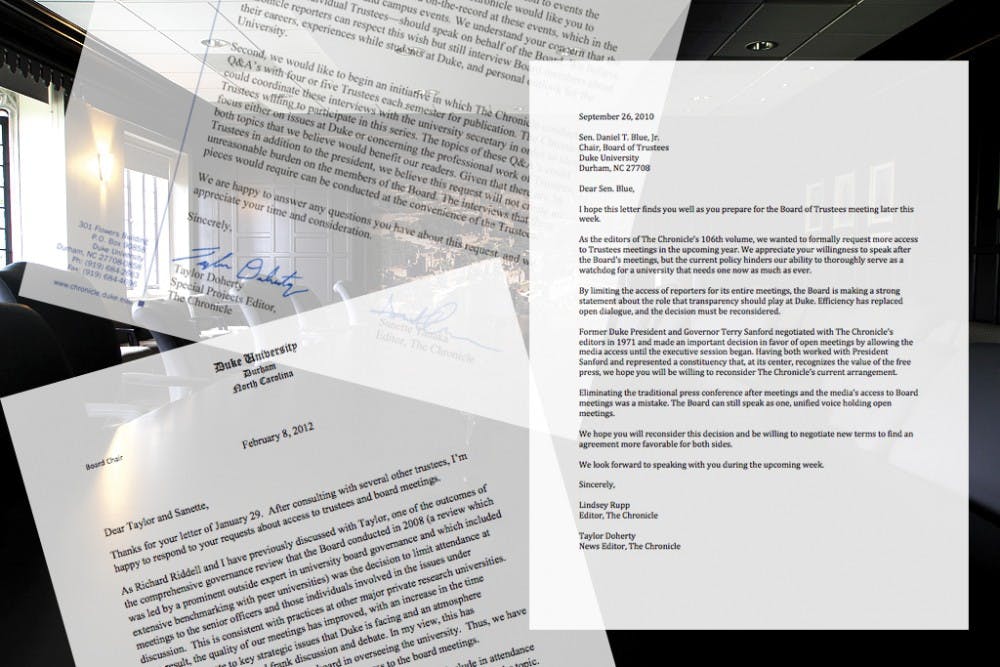Editor’s note: This is the final article of a three-part series focusing on the extent of transparency surrounding the Duke’s Board of Trustees. Today, The Chronicle details recent developments, including the outlook for access moving forward. Tuesday's article took a look at the Board’s decision under former President Terry Sanford to open Board meetings. Wednesday, The Chronicle turned the focus to the current relationship between the media and Trustees and explained why the Board decided to limit access.
Open Trustee meetings may be over forever.
Nearly 40 years after students led a sit-in that opened Board of Trustee meetings under President Terry Sanford, The Chronicle has renewed its efforts to raise the issue of Board transparency. In the last two years, Chronicle editors have requested increased access to Board proceedings, but most of these requests have been largely rebuffed by two different Board chairs.
In recent weeks, Board Chair Richard Wagoner, Trinity ’75, rejected The Chronicle’s request for open meetings, invitations to Trustee events and time on the Board’s February agenda to discuss the issue of transparency. He approved The Chronicle’s request for interviews with a few Board members each semester, but noted that per Board policy, the Trustees are not permitted to discuss affairs of the Board.
“This is only a partial victory for The Chronicle,” said Editor Sanette Tanaka, a senior. “While any additional degree of access is better than nothing, our level of access is still insufficient.”
Duke’s Board of Trustees is a 37-member group that sets Duke’s strategic vision and makes major decisions at the school ranging from hiring the University’s president to passing Duke’s multi-billion dollar budget. Although the Board’s meetings were once open to the media, the Trustees eliminated the final open session in 2008 under then-Board Chair Robert Steel, Trinity ’73.
“As a result [of closing the meetings], the quality of our meetings has improved, with an increase in the time available to devote to key strategic issues that Duke is facing and an atmosphere characterized by candid and frank discussion and debate,” Wagoner wrote in a letter to The Chronicle Feb. 8. “Thus, we have no plans to change the current policy for media access to the board meetings.”
Wagoner’s statement was prompted by a letter that Tanaka and this reporter sent Jan. 29 that requested more access. Chronicle editors sent a similar letter in September 2010 to then-Board Chair Dan Blue, Law ’73, that said the Board made “a strong statement about the role that transparency should play at Duke” and that the Board’s concerns for efficiency had “replaced open dialogue.” Blue rejected the request for open meetings and President Richard Brodhead wrote in an email thereafter that without confidentiality in the boardroom, “frank discussion doesn’t happen.”
Media casualties
Other local papers are affected by the closed-door policy but are not currently appealing the decision.
University Secretary Richard Riddell said Brodhead and the Board’s chair only conduct interviews with The Chronicle after meetings because other papers, including The (Raleigh) News & Observer and The Herald Sun, have not requested time.
Jane Stancill, who covers higher education for The News & Observer, said the paper does not cover Duke’s Board in-depth because “it is very difficult to get a handle on what they are doing.” The paper often relies on press releases drafted by Duke public relations staff for ideas for stories regarding the Board.
If the Trustees opened their sessions, Stancill said she would cover them. She pointed to the federal dollars and taxpayer money that Duke uses as reasons the public should expect more information.
“It would be better for Duke to be more transparent and more open,” Stancill said.
Herald Sun Editor Nancy Wykle said she believes her newspaper would also benefit from open Board sessions, and if the Trustees were willing to discuss the issue, the paper would definitely pursue increased access.
The local paper’s coverage of Duke is further complicated by financial challenges facing the media industry. As Brodhead noted in an interview, the reporters who remain at local newspapers now cover so many beats that they cannot visit campus as frequently as they once could.
“It was a bad day when I first learned that we could get a press release published as a news article,” Brodhead said. “That’s one of the causalities of the difficulties that the privately-owned media have been in recently. They’ve cut the staff so much that if you’ll send someone a press release, then that fills the inches, and so you can often get that to be the whole story. That’s not really the function of the media. I actually believe in the value of independent media, media as watchdogs and things of that sort, so I think that’s depressing.”
As other news organizations face cuts to resources that limit coverage, The Chronicle has an increased responsibility to cover the Trustees’ affairs, Tanaka said.
Whether the media can serve as the type of watchdog Brodhead said is important without access to meetings remains a point of contention.
Editor’s Note: In order to ensure objectivity, this story was edited by News Editor Nicole Kyle, who has not actively participated in negotiations for media access.
Get The Chronicle straight to your inbox
Signup for our weekly newsletter. Cancel at any time.

